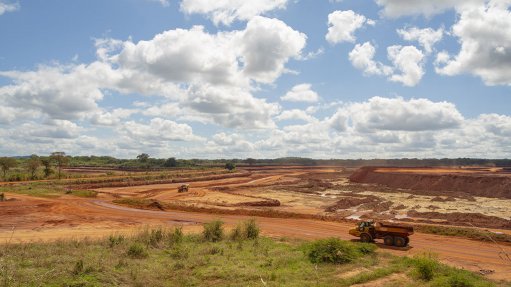Joburg diamonds reveal how Earth worked more than 3.5bn years ago
Diamonds dug up in Johannesburg between 1890 and 1930 have revealed how the Earth worked more than 3.5-billion years ago, according to new research.
"Because diamonds are some of the hardest, most robust material on Earth, they are perfect little time capsules and have the capacity to tell us what processes were occurring extremely early in earth’s history," Dr Katie Smart, a lecturer at the Wits School of Geoscience and the lead researcher said in a statement.
Smart, Professors Susan Webb and Lewis Ashwal from Wits, Professor Sebastian Tappe from the University of Johannesburg, and Dr Richard Stern from the University of Alberta in Canada, studied the period when modern-style plate tectonics began to operate on earth.
Their research, entitled Early Archaean tectonics and mantle redox recorded in Witwatersrand diamonds, was published in the journal Nature Geoscience this month.
Three diamonds used in the study were extracted from the 3-billion-year-old Witwatersrand Supergroup – the rock formation host to the famous Johannesburg gold mines, and were provided by Museum Africa.
Since the Earth is approximately 4.5-billion years old, and the rock record exists from about 4-billion years ago, the history of the most ancient rocks exposed on Earth’s surface has led to a heated debate among geoscientists over when plate tectonics began operating on earth.
Plate tectonics deals with the plates that make up the earth's outer shell. They glide over the mantle of the planet, which is the rocky layer above its core.
According to the university, the plate tectonic process is vital for shaping the earth as we know it. It causes "earthquakes, volcanic eruptions, and is responsible for constructing earth’s landscapes, such as deep sea trenches and building of mountains on the continents".
Many researchers believe plate tectonics began in the Archaean (the aeon from 4-billion to 2.5-billion years ago), although the exact timing is highly contested.
While the diamonds in the study were found in 3-billion-year-old sedimentary rocks, they were actually formed much deeper, in the mantle.
By using a probe to analyse the carbon and nitrogen isotope compositions of the diamonds, Smart and her team found that plate tectonics was likely in operation on Earth as early as 3.5-billion years ago.
"We can use the carbon and nitrogen isotope compositions of the diamonds to tell us where the source material involved in the formation of the Witwatersrand diamonds over 3-billion years ago came from," Smart said.
She said the nitrogen isotopes in the diamonds showed the nitrogen came from the earth's surface. This meant the nitrogen in the diamonds did not come from the mantle, but was transported from earth’s surface into the upper mantle through plate tectonics.
"This is important because the nitrogen trapped in the Witwatersrand diamonds indicates that plate tectonics, as we recognise it today, was operating on ancient Archaean earth, and actively transported material at earth’s surface deep into the mantle," she said.
“Various researchers have tried to establish when exactly plate tectonics started on earth, but while there are many investigations of ancient rocks on earth’s surface – like the 3.5-billion year old Barberton Greenstone Belt here in South Africa, or the 4-billion year old Acasta Gneiss in northwest Canada – we are looking at the problem from a different viewpoint - by investigating minerals derived from earth’s mantle,” Smart said.
They were not the first researchers to study diamonds to tell when plate tectonics began, but this study of Archaean diamonds suggested that plate tectonics was in operation by at least 3.5-billion years.
Comments
Press Office
Announcements
What's On
Subscribe to improve your user experience...
Option 1 (equivalent of R125 a month):
Receive a weekly copy of Creamer Media's Engineering News & Mining Weekly magazine
(print copy for those in South Africa and e-magazine for those outside of South Africa)
Receive daily email newsletters
Access to full search results
Access archive of magazine back copies
Access to Projects in Progress
Access to ONE Research Report of your choice in PDF format
Option 2 (equivalent of R375 a month):
All benefits from Option 1
PLUS
Access to Creamer Media's Research Channel Africa for ALL Research Reports, in PDF format, on various industrial and mining sectors
including Electricity; Water; Energy Transition; Hydrogen; Roads, Rail and Ports; Coal; Gold; Platinum; Battery Metals; etc.
Already a subscriber?
Forgotten your password?
Receive weekly copy of Creamer Media's Engineering News & Mining Weekly magazine (print copy for those in South Africa and e-magazine for those outside of South Africa)
➕
Recieve daily email newsletters
➕
Access to full search results
➕
Access archive of magazine back copies
➕
Access to Projects in Progress
➕
Access to ONE Research Report of your choice in PDF format
RESEARCH CHANNEL AFRICA
R4500 (equivalent of R375 a month)
SUBSCRIBEAll benefits from Option 1
➕
Access to Creamer Media's Research Channel Africa for ALL Research Reports on various industrial and mining sectors, in PDF format, including on:
Electricity
➕
Water
➕
Energy Transition
➕
Hydrogen
➕
Roads, Rail and Ports
➕
Coal
➕
Gold
➕
Platinum
➕
Battery Metals
➕
etc.
Receive all benefits from Option 1 or Option 2 delivered to numerous people at your company
➕
Multiple User names and Passwords for simultaneous log-ins
➕
Intranet integration access to all in your organisation


















